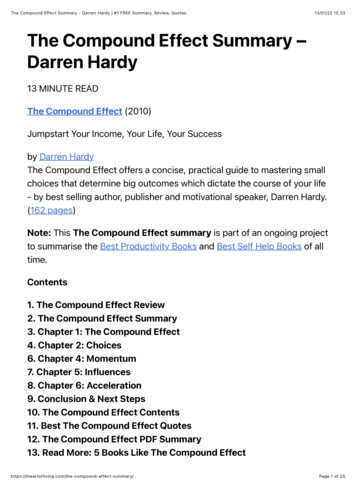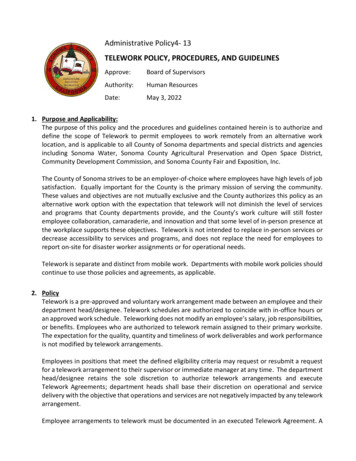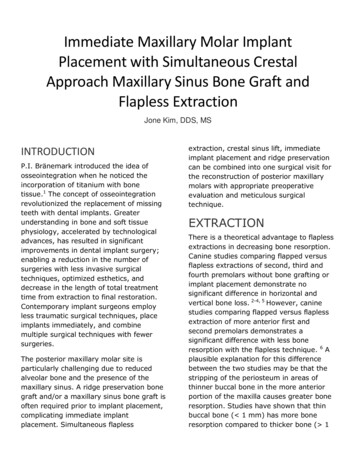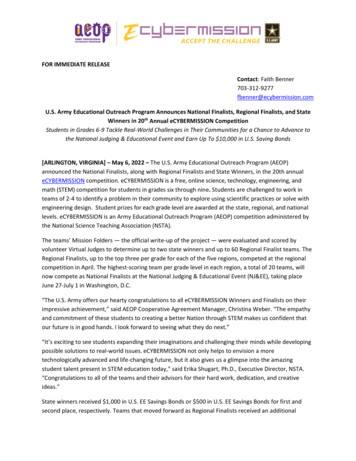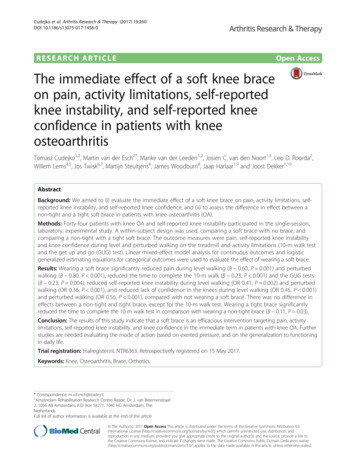
Transcription
Cudejko et al. Arthritis Research & Therapy (2017) 19:260DOI 10.1186/s13075-017-1456-0RESEARCH ARTICLEOpen AccessThe immediate effect of a soft knee braceon pain, activity limitations, self-reportedknee instability, and self-reported kneeconfidence in patients with kneeosteoarthritisTomasz Cudejko1,2, Martin van der Esch2*, Marike van der Leeden1,2, Josien C. van den Noort1,3, Leo D. Roorda2,Willem Lems4,5, Jos Twisk6,7, Martijn Steultjens8, James Woodburn8, Jaap Harlaar1,9 and Joost Dekker1,10AbstractBackground: We aimed to (i) evaluate the immediate effect of a soft knee brace on pain, activity limitations, selfreported knee instability, and self-reported knee confidence, and (ii) to assess the difference in effect between anon-tight and a tight soft brace in patients with knee osteoarthritis (OA).Methods: Forty-four patients with knee OA and self-reported knee instability participated in the single-session,laboratory, experimental study. A within-subject design was used, comparing a soft brace with no brace, andcomparing a non-tight with a tight soft brace. The outcome measures were pain, self-reported knee instabilityand knee confidence during level and perturbed walking on the treadmill and activity limitations (10-m walk testand the get up and go (GUG) test). Linear mixed-effect model analysis for continuous outcomes and logisticgeneralized estimating equations for categorical outcomes were used to evaluate the effect of wearing a soft brace.Results: Wearing a soft brace significantly reduced pain during level walking (B 0.60, P 0.001) and perturbedwalking (B 0.80, P 0.001), reduced the time to complete the 10-m walk (B 0.23, P 0.001) and the GUG tests(B 0.23, P 0.004), reduced self-reported knee instability during level walking (OR 0.41, P 0.002) and perturbedwalking (OR 0.36, P 0.001), and reduced lack of confidence in the knees during level walking (OR 0.45, P 0.001)and perturbed walking (OR 0.56, P 0.001), compared with not wearing a soft brace. There was no difference ineffects between a non-tight and tight brace, except for the 10-m walk test. Wearing a tight brace significantlyreduced the time to complete the 10-m walk test in comparison with wearing a non-tight brace (B 0.11, P 0.03).Conclusion: The results of this study indicate that a soft brace is an efficacious intervention targeting pain, activitylimitations, self-reported knee instability, and knee confidence in the immediate term in patients with knee OA. Furtherstudies are needed evaluating the mode of action based on exerted pressure, and on the generalization to functioningin daily life.Trial registration: trialregister.nl, NTR6363. Retrospectively registered on 15 May 2017.Keywords: Knee, Osteoarthritis, Brace, Orthotics* Correspondence: m.vd.esch@reade.nl2Amsterdam Rehabilitation Research Centre Reade, Dr. J. van Breemenstraat2, 1056 AB Amsterdam, P.O. Box 58271, 1040 HG Amsterdam, TheNetherlandsFull list of author information is available at the end of the article The Author(s). 2017 Open Access This article is distributed under the terms of the Creative Commons Attribution 4.0International License (http://creativecommons.org/licenses/by/4.0/), which permits unrestricted use, distribution, andreproduction in any medium, provided you give appropriate credit to the original author(s) and the source, provide a link tothe Creative Commons license, and indicate if changes were made. The Creative Commons Public Domain Dedication o/1.0/) applies to the data made available in this article, unless otherwise stated.
Cudejko et al. Arthritis Research & Therapy (2017) 19:260BackgroundSoft braces are elastic, non-adhesive orthoses recommended in the non-surgical management of patients withknee osteoarthritis (OA) [1]. Because of ease of use, lackof complications, and low cost, soft braces are commonlyused with the aim of reducing pain and activity limitations[1]. Soft brace efficacy and effectiveness has been assessedin laboratory [2, 3] and ambulatory settings [4, 5]. Alaboratory setting allows the assessment of the immediateefficacy of an intervention under controlled conditions,while an ambulatory setting allows the assessment of theeffectiveness in real life, where uncontrollable factors maybe present. The evidence for immediate efficacy of a softbrace in patients with knee OA is limited. A recentsystematic review with meta-analyses on soft bracing inknee OA showed an immediate, moderate improvementin pain when wearing a soft brace [6]. As the results werebased on only two studies of low to moderate quality,however, further studies are needed.It is not well-understood how a soft brace might reduce activity limitations and pain in patients with kneeOA. A decrease in pain might be due to sensory stimulation of the skin, leading to a reduction in transmissionof pain signals [7]. It is also assumed that a soft bracestimulates cutaneous mechanoreceptors, resulting in improved joint proprioception accuracy, which may havean impact on knee joint stability [2]. Improved kneejoint stability might reduce activity limitations [8, 9]. Toour knowledge, there is only one study that showed thata soft brace improves self-reported knee instability [3],while the effect of a soft brace on instability-related lackof confidence in the knee [10] is unknown. Externallyapplied perturbations challenge knee stabilization strategies in patients with knee OA [11, 13]. Perturbed conditions therefore provide a powerful test of soft braces.However, whether a soft brace has an effect on knee stability and knee confidence in perturbed conditions hasnot been assessed yet. Given the high prevalence of selfreported knee instability and lack of confidence in theknee in patients with knee OA [9, 14], there is a need tostudy the effect of a soft brace on knee stability and kneeconfidence during both level and perturbed walk.Hassan et al. [15] reported that a non-tight soft bracewas more effective than a tight brace in reducing painand improving postural sway in patients with knee OA.The authors suggested that a non-tight brace providesmore recurrent stimuli to cutaneous mechanoreceptors,whereas a tight brace provides constant pressure, towhich skin mechanoreceptors adapt [15]. There is aclear need to replicate this study in order to determinewhether the level of tightness has an effect on activitylimitations, knee stability and knee confidence.The currently available evidence for the use of softbraces in patients with knee OA is limited and of lowPage 2 of 9quality. Thus, the aims of the study were to (i) evaluatethe immediate effect of a soft brace on pain, activity limitations, and self-reported knee instability and knee confidence, and to (ii) assess the difference in effect betweena non-tight and a tight soft brace in patients with kneeOA. We hypothesized that (i) a soft brace reduces pain,activity limitations, and self-reported knee instability,and improves knee confidence, and that (ii) a non-tightsoft brace has a greater effect than a tight soft brace.MethodsTrial designIn this single-session, laboratory, experimental study, awithin-subject design was used, comparing a soft bracewith no soft brace, and comparing a non-tight with atight soft brace. The order of the non-tight and tightbrace was randomized, using a computer generated random sequence made prior to the study. All participantswere blinded to the type of brace (non-tight or tight).ParticipantsParticipants were recruited from the Amsterdam Osteoarthritis (AMS-OA) cohort through telephone-basedscreening between August 2015 and April 2016. TheAMS-OA cohort consists of participants with established knee and/or hip OA according to the AmericanCollege of Rheumatology (ACR) criteria [16], who hadbeen referred to an outpatient rehabilitation center(Reade, Center for Rehabilitation and Rheumatology,Amsterdam, the Netherlands). Participants were assessedby rheumatologists, radiologists, and rehabilitation physicians. According to the ACR criteria, knee OA is diagnosed if knee pain is present and three of the followingsix parameters are present: age 50 years, morning stiffness 30 minutes, crepitus, bony tenderness, bony enlargement and no palpable warmth. The inclusioncriteria for the present study were (i) diagnosis of bilateral or unilateral knee OA according to the ACR criteria[16], (ii) age between 50 and 80 years, and (iii) presenceof self-reported knee instability in the past 3 months.Self-reported knee instability was defined as at least oneepisode of buckling, shifting, or giving way of the kneein the last three months, reported by participants [17].The exclusion criteria for the AMS-OA cohort weretotal knee replacement and/or inflammatory arthritis(including rheumatoid arthritis, crystal arthropathy, septic arthritis, and spondylarthropathy). Additional exclusion criteria for the present study were (i) radiographicpatello-femoral (PF) joint OA (PFOA), and (ii) presenceof comorbidity resulting in severe activity limitations.The soft brace in the current study did not involve patellar opening, thus, to avoid applying pressure on the PFcompartment, we excluded patients with PFOA.
Cudejko et al. Arthritis Research & Therapy (2017) 19:260InterventionsA commercially available soft brace (GENUTEX A2, Human I; Bleiswijk, The Netherlands) was used. The following sizes of the soft brace were available: S: 30–35cm, M: 35–40 cm, L: 40–45 cm, XL: 45–50 cm, andXXL: 50–55 cm. These sizes were used to differentiatebetween a non-tight and tight soft brace. A tight bracewas defined as one fitted based on shank and thigh circumferences measured according to instructions provided by the distributor. A non-tight brace was definedas one a size larger than a tight brace. Fitting and positioning of the brace were performed by a trained investigator (TC) according to instructions provided by thedistributor. Both knees were braced regardless of theknee OA status. Participants were allowed to become accustomed to the brace before treadmill walking. Participants were blinded to the type of brace by informingthem that the study was a comparison of two differentbraces, without mentioning differences in tightness.Braces were identical in appearance.Primary outcome measurePainKnee pain during walking on the treadmill was assessedusing the Dutch-translated 11-point numerical ratingscale (NRS) (0–10), with higher scores representingmore pain [18]. The following question was asked duringboth level and perturbed walking: “On a scale from 0 to10, how would you score the level of your left/right kneepain while walking on the treadmill?” The Dutch translated NRS has been frequently used in the Netherlands[17, 19, 20].Secondary outcome measuresActivity limitationsActivity limitations were assessed with two standardizedphysical performance tests: the 10-m walk test [21] andthe get up and go (GUG) test [22]. The 10-m walk testassesses the time to walk a distance of 10 m along a leveland unobstructed corridor [21]. Participants wereinstructed to walk as fast as possible and timed with astopwatch. The GUG test measures the time a persontakes to get up from a chair and walk 15 m as fast aspossible along a level and unobstructed corridor [23].The intraclass correlation coefficient (ICC) for the GUGtest is 0.98 for intra-tester reliability and 0.98 for intertester reliability [22].Page 3 of 9giving way, separately for the right and left knee. Thefollowing question was asked during both level and perturbed walking: “How many times have you had a sensation of left/right knee buckling, shifting, or giving waywhile walking on the treadmill?” Self-reported knee instability was dichotomized into no episode of knee instability versus one or more episodes of knee instability.The translated Dutch version of the questionnaire hasbeen previously used by our research group [20, 25].Self-reported knee confidenceKnee confidence was assessed using a 5-point Likertscale (not at all, mildly, moderately, severely, and extremely) in response to the question asked during bothlevel and perturbed walking: “How much were you troubled with lack of confidence in your left/right knee whilewalking on the treadmill?” This is a single item from theDutch-validated Knee injury and Osteoarthritis Outcome Score (KOOS) [26–28]. Self-reported knee confidence was dichotomized into lack (mildly, moderately,severely, or extremely troubled) versus full (not troubledat all) knee confidence.Other measuresParticipants’ demographic and clinical characteristics were recorded prior to testing and included: age,gender, duration of symptoms, body-mass index (BMI),knee OA radiographic severity, and muscle strength.BMI was calculated as body mass in kilograms dividedby height in square meters. The Kellgren and Lawrencescore (KL score) from the more severely affected kneewas used to assess the radiographic severity of the disease [29]. Conventional radiographs of tibiofemoraljoints were made by a weight-bearing posterior-anteriorview according to Buckland-Wright et al. [30]. Two independent observers graded radiographs: a bone andjoint radiologist and an epidemiologist trained by twomusculoskeletal radiologists. Muscle strength (in Newton meters per kilogram of body weight (Nm/kg)) wasassessed for flexion and extension of the knee using anisokinetic dynamometer (Humac Norm, CSMi, Boston,USA) according to a previously described protocol [11].The mean strength of the quadriceps and hamstringmuscles of the left and right knee was reported. TheDutch translation of the Western Ontario and McMasterUniversities Osteoarthritis Index (WOMAC) was usedto assess self-reported knee pain, stiffness, and activitylimitations of the most affected knee [12, 13].Self-reported knee instabilitySelf-reported knee instability was assessed with theDutch version of the questionnaire developed by Irrganget al. [24]. Self-reported knee instability was assessedwith a question on the number of episodes during walking on the treadmill of perceived buckling, shifting, orSample sizeThe study was powered on self-reported pain. An expected effect size of 0.5 was calculated from the changein pain and its confidence interval reported in the studyof Hassan et al. [15]. With effect size 0.5, alpha 0.05,
Cudejko et al. Arthritis Research & Therapy (2017) 19:260Page 4 of 9power (1-β) 0.80, and a two-sided test, the minimumnumber of subjects required was n 33. Allowing for anattrition rate of 10% during the course of the study [31],this study needed to include at least 36 patients.the order of the type of brace we controlled the potentialconfounding effect of fatigue and learning effects on thecomparison between a non-tight versus tight brace.Statistical analysisProcedureThe study procedure is presented in Table 1. Participantsof the study attended a single testing session. Outcomemeasures, with the exception of the 10-m walk andGUG tests, were assessed on the treadmill, which is integrated into the GRAIL system. The GRAIL system ismade up of a treadmill with a dual belt, placed in a virtual reality environment (GRAIL system, MOTEKForceLink, The Netherlands). Walking on the treadmill wasinitially performed with no brace. Patients had afamiliarization session on the treadmill lasting at leastone minute, during which walking speed was determined. They were instructed to walk at a comfortable,self-selected pace while shod and wearing a safety harness. Following the familiarization session, participantswere subjected to two tasks (without wearing a brace):(i) level walking for 2 minutes and (ii) walking withmechanical perturbations on the treadmill. Mechanicalperturbations on the treadmill comprised five lateralmedial translations (2 cm displacements) of the treadmillbelts during the stance phase of a gait cycle. For safetyreasons, participants were informed about mechanicalperturbations in advance. The mechanical perturbationsof the treadmill occurred at random moments. Immediately following each of the two tasks, participants reportedtheir average levels of knee pain, number of knee instability episodes, and perceived knee confidence. Subsequently,participants were randomized to receive a non-tight ortight brace and the two tasks were repeated while wearinga brace. Prior to testing on the treadmill, the 10-m walkand GUG tests were performed without the brace. Following testing on the treadmill, the 10-m walk and GUG testswere repeated with the brace (non-tight or tight).After a 30-minute rest, the procedure crossed over tothe second part of the assessments but with another typeof soft brace (tight or non-tight). By counterbalancingDescriptive statistics were used to characterize the studypopulation. Numbers (percentages) were used for categorical variables, and means (SD) for continuous variables. Prior to the statistical analysis, outcome measureswere checked for normality using the Shapiro–Wilk andKolmogorov–Smirnov tests. Pain and self-reported kneeinstability and knee confidence were obtained for eachknee separately (knee-level variable), and data from bothknees were used in the statistical analysis. Data on the10-m walk and GUG tests were analyzed as person-levelvariables. Four comparisons were analyzed: (i) brace versus no brace, (ii) tight brace versus no brace (i.e., baseline before tight), (iii) non-tight brace versus no brace(i.e., baseline before non-tight), and (iv) non-tight braceversus tight brace. Linear mixed-effect model analysisfor repeated measurements within participants was usedfor continuous outcome measures (pain, 10-m walk test,GUG test). Logistic generalized estimating equations(GEE) analysis with an exchangeable working correlationmatrix was used for dichotomous outcome measures(self-reported knee instability and knee confidence). Nocovariates were included in the models, because additionof a covariate to a repeated measures analysis does notalter the main effects of a within-subject factor (e.g., age,gender, etc. are the same at each data point) [32]. Statistical significance was accepted at P 0.05. All analyseswere performed using SPSS software, version 22.0 (SPSS,Chicago, IL, USA).ResultsThere were 214 persons from the AMS-OA cohort initially contacted for eligibility; 144 persons declined toparticipate and 26 did not meet the inclusion criteria forthe following reasons: absence of self-reported knee instability in the last 3 months (n 13), comorbidity severely affecting daily functioning (n 8), or age notTable 1 Study procedureBaseline assessmentwithout an SBIntervention assessmentwith an SBa1. 10-m walk test2. GUG test3. Level walkA. PainB. SKI and SCI4. Perturbed walkA. PainB. SKI and SCI1. Level walkA. PainB. SKI and SCI2. Perturbed walkA. PainB. SKI and SCI3. 10-m walk test4. GUG testRestbBaseline assessmentwithout an SBIntervention assessmentwith an SBa1. 10-m walk test2. GUG test3. Level walkA. PainB. SKI and SCI4. Perturbed walkA. PainB. SKI and SCI1. Level walkA. PainB. SKI and SCI2. Perturbed walkA. PainB. SKI and SCI3. 10-m walk test4. GUG testSB soft brace, SKI self-reported knee instability, GUG get up and go test, SCI self-reported knee confidenceaTight or non-tight soft bracebRest of 30 minutes
Cudejko et al. Arthritis Research & Therapy (2017) 19:260Page 5 of 9between 50 and 80 years (n 5). In total, 44 patientswith knee OA and self-reported knee instability participated in the study. Demographics and clinical characteristics of the participants are shown in Table 2. Theparticipants had a mean SD age of 65.7 9.3 years, amean SD BMI of 29.8 5.5 kg/m2, and 29 (65.9%) werewomen.Descriptive data on pain and activity limitations by theconditions are presented in Table 3. The results of thestatistical evaluation of the outcomes are presented inTable 4. Wearing a soft brace significantly reduced painduring level walking (B 0.60, P 0.001) and perturbedwalking (B 0.80, P 0.001), reduced the time tocomplete the 10-m walk test (B 0.23, P 0.001) andGUG test (B 0.23, P 0.004), reduced self-reportedknee instability during level walking (OR 0.41, P 0.002)and perturbed walking (OR 0.36, P 0.001), and reducedlack of confidence in the knees during level walking (OR0.45, P 0.001) and perturbed walking (OR 0.56, P 0.001), compared with not wearing a soft brace (Table 4,column 2).Whether the brace was non-tight or tight, the effectswere similar (Table 4, columns 3 and 4). There was noTable 2 Descriptive statistics of the study participants (n 44)VariableValueAge (years)65.7 (9.3)Female, number (%)29 (65.9)2Body mass index (kg/m )29.8 (5.5)Duration of symptoms (years)13.0 (10.3)Pain last week (NRS, range 0–10)4.7 (1.9)WOMAC, pain (range 0–20)8.8 (4.0)WOMAC, stiffness (range 0–8)4.6 (1.7)WOMAC, physical function (range 0–68)32.5 (12.7)WOMAC, total score (range 0–96)45.9 (17.5)Muscle strength, (Nm/kg)0.88 (0.33)Walking speed on the treadmill, (m/s)0.74 (0.24)KL grade, number (%)0 (none)3 (7.0)1 (doubtful)16 (37.2)2 (mild)9 (20.9)3 (moderate)10 (23.3)4 (severe)5 (11.6)Self-reported knee instability 3 months, number (%)Rarely (1–2 times)13 (29.5)Regularly (3–4 times)18 (40.9)Very often ( 4 times)13 (29.5)Categorical variables are presented as numbers (percentage); continuousvariables are presented as means SDNRS numeric rating scale, WOMAC Western Ontario and McMaster UniversitiesOsteoarthritis Index KL Kellgren–Lawrence scoredifference in effects between a non-tight and tight brace,except for the 10-m walk test. Wearing a tight brace significantly reduced the time to complete the 10-m walktest in comparison with wearing a non-tight brace (B 0.11, P 0.03) (Table 4, column 5).To determine whether the beneficial effects were inmost participants or predominantly due to large effectsin a few, the effect of wearing a soft brace on the outcome measures has been calculated per individual andpresented on the histograms. The distribution of the individual effects per outcomes was fairly normal indicating that the overall beneficial effects are not attributableto large effects in a few participants [33].DiscussionIn this study, we found that a soft brace reduced activitylimitations and pain, and improved self-reported kneestability and knee confidence in patients with knee OA.We did not find significant differences between a nontight and a tight brace, with the exception of performingthe 10-m walk test. The results support the use of a softbrace as an efficacious treatment option in the immediate management of patients with knee OA.This is the first high-quality study reporting on the immediate effect of wearing a soft brace, on pain, activitylimitations, and self-reported knee instability, and kneeconfidence in patients with knee OA. The results of therecent systematic review on soft bracing in knee OA [6]showed that the quality of previous studies [2, 3, 15]ranged from low [3, 15] to fair [2] according to theDowns and Black scale [34]. If our study is scored according to the same criteria [34], the study is scored as agood-quality study (i.e., study quality percentage 68%).Compared to previous studies, our study received ahigher score in the Downs and Black scale in statisticalanalysis, representativeness of the study population, andreporting on the facilities where patients were assessed.The size of the effect on pain in our study is comparable to those observed in previous studies [2, 3, 15]. Bryket al. [2] observed a 0.6 mm reduction in the visual analog scale (VAS) for pain during the Stair Climb PowerTest (SCPT), while Schween et al. [3] and Hassan et al.[15] reported a similar decrease in the VAS for pain during level walking. We observed a 0.6-point (95% CI 0.97–0.23) and 0.8-point (95% CI 1.11–0.43) decreasein pain on the NRS for level and perturbed walking, respectively. This effect is close to the 1-point thresholdfor the minimal clinically important difference for NRSpain [35].To our knowledge, only Bryk et al. [2] usedperformance-based physical tests to evaluate the immediate effect of a soft brace on activity limitations in patients with knee OA. Our study confirms their findings[2]. We found that wearing a soft brace significantly
Cudejko et al. Arthritis Research & Therapy (2017) 19:260Page 6 of 9Table 3 Pain and activity limitations by the conditions, mean (SD)OutcomesNo braceBraceNo braceTight braceNo braceNon-tight braceTight braceNon-tight bracePain, level walka3.28 (2.8)2.67 (2.7)3.44 (3.0)2.83 (2.7)3.14 (2.7)2.53 (2.7)2.79 (2.7)2.55 (2.7)Pain, perturbed walka3.41 (2.9)2.60 (2.8)3.51 (2.9)2.76 (2.9)3.33 (2.9)2.47 (2.6)2.72 (2.9)2.50 (2.6)b10-m walk test7.04 (1.8)6.81 (2.0)6.89 (1.7)6.67 (1.9)7.11 (2.0)6.89 (2.1)6.75 (1.9)6.86 (2.1)GUG testb10.89 (3.2)10.66 (3.6)10.65 (2.8)10.57 (3.5)11.13 (3.5)10.75 (3.7)10.58 (3.5)10.70 (3.7)GUG get up and go testaNumeric rating scale (range 0–10)bSecondsreduced time to complete both the 10-m walk and GUGtests by 0.23 s (95% CI 0.31–0.13 and 0.38–0.07, respectively). In the absence of information on the minimal clinically important change in these measures, theclinical relevance of these effects cannot be evaluated.Furthermore, these effects should be viewed in the lightof this being a laboratory-based study and the short duration of brace use. Further research on generalization tofunctioning in daily life and the clinical relevance ofthese effects in daily life is indicated.Previously, only one study had observed that a softbrace improved self-reported knee instability [3], whilethe effect on knee confidence had not been studied before. The present study confirms that a soft brace improves self-reported knee stability, and is the first studyto show that a soft brace improved confidence in theknees, in patients with knee OA. These results are noteworthy, given that self-reported knee instability has beenreported in the majority ( 60%) of patients with kneeOA [9, 14], and that it may affect their quality of life [9,25]. Knee confidence may influence decisions about participation in physical activity. Lack of confidence mayforce patients with knee OA to alter their daily activities,to avoid knee buckling and pain [36]. A soft brace maytherefore indirectly influence daily activities via the improvement of knee instability and knee confidence.This is the first study using external perturbations onthe treadmill to evaluate the effect of a soft brace onpain, and on self-reported knee instability and knee confidence. External perturbations provide a more stimulating and challenging environment for knee stability [37],and simulate situations in which patients might experience increased knee instability and lack of confidence.Knee OA could affect the ability of the neuromuscularsystem to execute appropriate commands in response toexternal challenges, resulting in joint instability [37]. It istherefore important to show that, even when participants were subjected to external perturbations, the effectof wearing a soft brace on pain and self-reported kneeinstability and knee confidence continued.The second aim of this study was to assess the difference in effect between a non-tight and a tight brace. Wehypothesized that a non-tight brace would elicit strongereffects than a tight brace. This hypothesis was based onTable 4 Statistical evaluation of the outcome measures by the comparisonsBrace vs. no braceP valueTight brace vs.no braceP valueNon-tight brace vs.no braceP valueNon-tight vs. tightbraceP valuePain, level walk 0.60 ( 0.97–0.23)0.001* 0.60 ( 1.01–0.06)0.028*Pain, perturbedwalk 0.80 ( 1.11–0.43) 0.001** 0.75 ( 1.31–0.02)0.012*–0.60 ( 1.01–0.07)0.026* 0.24 ( 0.77 0.29)0.37 0.86 ( 1.36–0.36)0.001* 0.21 ( 0.44 0.30)0.4110 m walk test 0.23 ( 0.31–0.13) 0.001**–0.22 ( 0.33–0.10)GUG test 0.23 ( 0.38–0.07)0.004* 0.08 ( 0.25 0.08) 0.001** 0.23 ( 0.31–0.14) 0.001**0.11 (0.01 0.20)0.03*0.335 0.38 ( 0.57–0.17) 0.001**0.12 ( 0.03 0.27)0.13Outcomes, B (95% CI)aOutcomes, OR (95% CI)baKnee instability,level walk0.41 (0.23 0.66)0.002*0.37 (0.19 0.68)0.002*0.46 (0.22 0.93)0.018*1.06 (0.65 1.73)0.79Knee instability,perturbed walk0.36 (0.22 0.59) 0.001**0.34 (0.18 0.62)0.001*0.39 (0.22 0.67)0.001*1.15 (0.66 2.0)0.59Knee confidence,level walk0.45 (0.31 0.65) 0.001**0.48 (0.31 0.74)0.001*0.42 (0.27 0.65) 0.001**1.07 (0.75 1.51)0.69Knee confidence,perturbed walk0.56 (0.38 0.82) 0.001**0.62 (0.35 0.77)0.004*0.63 (0.40 0.96)0.033*0.97 (0.60 1.56)0.91Beta (B) coefficients (95% CI): negative value indicates reduced mean value of the outcome measure when wearing a braceOdds ratios (OR) (95% CI): value 1 indicates reduced chance of self-reported knee instability and lack of confidence in the knees when wearing a brace*Significant at a P value 0.05; **significant at a P value 0.001b
Cudejko et al. Arthritis Research & Therapy (2017) 19:260a study reporting that a non-tight brace reduced painand improved postural sway more than a tight brace[15]. Hassan et al. [15] speculated that a non-tight braceprovided more recurrent stimuli, by allowing movementbetween the brace and the skin, and thus elicited continuous response from cutaneous receptors. By contrast,a tight brace might provide constant pressure, to whichskin mechanoreceptors adapt. Our hypothesis was notconfirmed. Differences in the type of the brace may bean explanation. Hassan et al. [15] used a tubigrip elasticbandage, whereas we used a soft brace specifically designed for the knee joint. More importantly, we are unaware whether the level of pressure exerted on the skinby our soft brace was comparable to that used by Hassanet al. [15]. There is therefore a need to develop a reliableand valid measure of tightness.Because a soft brace is an efficacious intervention,there is a need to understand the mechanisms underlying the effect. Soft braces might reduce self-reportedknee instability by altering proprioceptive feedback [15]and enhancing muscle activity [38]. Mild compressionprovided by a soft brace
total knee replacement and/or inflammatory arthritis (including rheumatoid arthritis, crystal arthropathy, sep-tic arthritis, and spondylarthropathy). Additional exclu-sion criteria for the present study were (i) radiographic patello-femoral (PF) joint OA (PFOA), and (ii) presence of comorbidity resulting in severe activity limitations.






